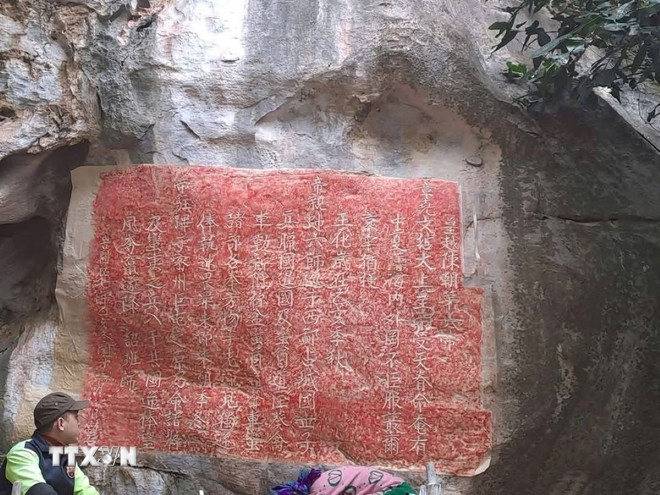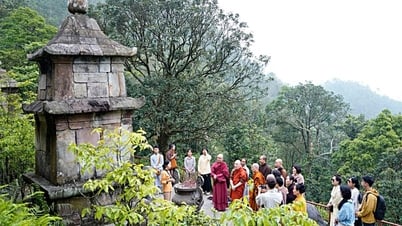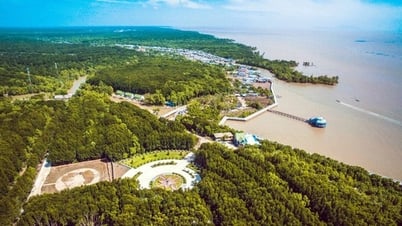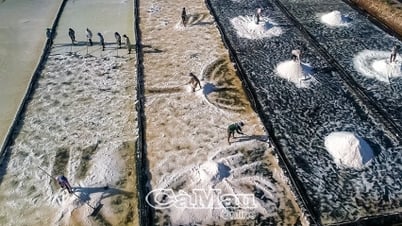Ma Nhai Stele is the only historical relic left in Con Cuong, Nghe An, carved into a rock mountain, dating back nearly 700 years (1335). In 2011, the Ministry of Culture, Sports and Tourism recognized Ma Nhai Stele as a National Historical Relic.
Unique Ma Nhai beer
The Ma Nhai stele records the Tran Dynasty's achievements in protecting the border, conquering foreign invaders, and reclaiming lost land, demonstrating the prestige of the Dai Viet State in the cause of consolidating the nation's independence.
In the early 14th century, under the Tran Dynasty, the diplomatic relations between Dai Viet and neighboring countries such as Ai Lao and Champa were complicated. Taking advantage of that situation, some tribes in the West, bordering Nghe An , with the support of Ai Lao, repeatedly sent troops to invade and plunder, causing great suffering to the people.
In order to demonstrate the strength of Dai Viet, and at the same time to protect the border and protect the people's lives, in the year At Hoi, the 7th year of Khai Huu reign (1335) of King Tran Hien Tong, the retired Emperor Tran Minh Tong decided to personally lead the army, "personally commanding the army, giving strict orders, with resounding prestige" to attack Ai Lao.
After pacifying the country, the Supreme Emperor ordered the Transport Envoy Nguyen Trung Ngan to compose an inscription to commemorate the victory on the cliff. Currently, the stele remains at Thanh Nam Mountain, Chi Khe Commune, Con Cuong District, Nghe An Province. The entire inscription is short, only 14 lines with 155 words, deeply engraved on a large limestone cliff (213cmx155cm). Interestingly, the strokes on the stele are record-breakingly large, ranking among the largest stone steles in Vietnam, with each letter having an average diameter of about 10.5cm. The book Dai Nam Nhat Thong Chi recorded "... the letters are as big as a hand, engraved more than 1 inch deep into the rock, and still remain today."
The Department of Culture, Sports and Tourism of Nghe An province coordinated with experts from the Vietnam Fine Arts Museum and the Tran Nhan Tong Institute to carry out the work of copying the text of the Ma Nhai stele. (Photo: VNA)
According to statistics from the French Far East Institute, by 1945, 1,157 steles had been found in our country, mainly from the Le and Nguyen Dynasties, most of which were made from monolithic stone. The most unique are the steles carved on rocky mountains such as the Ma Nhai stele (ma: grind, nhai: cliff) because this is a stele carved directly on the rocky mountain. These steles often record the marches or tours of kings. The Ma Nhai ky cong bi van stele of the Imperial Doctor Nguyen Trung Ngan is one of the oldest Ma Nhai steles in Vietnam today. This is a particularly rare document in the research of history and literature.
Currently, Ma Nhai stele is still preserved by the local government as a message reminding future generations to always remember the great contributions of our ancestors in the cause of protecting the country's borders and independence. It is a lasting testament to the spirit of solidarity, strong will, and aspiration to unify the country and keep the country peaceful of the Dai Viet people. This is a valuable heritage that needs to be preserved to leave a mark of our ancestors' time, in order to educate the younger generation about the history of the nation.
Proposal to recognize Ma Nhai stele as a National Treasure
Chairman of the People's Committee of Con Cuong District Lo Van Thao said that in mid-March 2025, the Department of Culture, Sports and Tourism invited experts from the Department of Heritage of the Ministry of Culture, Sports and Tourism to directly survey the national historical relic Ma Nhai stele and worked with Con Cuong district to advise on the procedures for submitting to the Central Government for recognition as a National Treasure. Accordingly, the experts came to assess the value of Ma Nhai stele. Through the survey, the delegation found that the Ma Nhai stele relic is completely worthy of being ranked as a National Treasure, this is a priceless literary treasure of Nghe An.
“Elevating the value of Ma Nhai stele to a National Treasure is not only a worthy recognition of the historical and cultural values that this relic brings, but also an important contribution to the preservation and promotion of the cultural heritage values of the nation. At the same time, it contributes to promoting cultural tourism, attracting tourists to Con Cuong, contributing to the socio-economic development of the locality,” affirmed Chairman of the People's Committee of Con Cuong district Lo Van Thao.
Currently, the Provincial Relic Management Board is rebuilding the National Treasure dossier for Ma Nhai stele, including assessments from international and domestic experts on the value of Ma Nhai stele, collecting official documents, researching and studying Ma Nhai stele.
Elevating the value of Ma Nhai stele to a National Treasure is not only a worthy recognition of the historical and cultural values that this relic brings, but also an important contribution to the preservation and promotion of the nation's cultural heritage values and tourism development. (Photo: VNA)
To achieve this goal, the Department of Culture, Sports and Tourism of Nghe An province coordinated with experts from the Vietnam Fine Arts Museum and the Tran Nhan Tong Institute to reproduce the text of the Ma Nhai stele.
In fact, steles are often easily affected by time, weather and natural erosion. By printing (sticking do paper on the surface of the stele and rubbing special ink to make the letters stand out, printing on the do paper from which the red/black letters will be clearly printed), it is possible to preserve the content engraved on the stele clearly and in detail without having to come into frequent contact with the original artifact, helping to protect the artifact from damage caused by direct contact.
According to Ms. Tran Thi Kim Phuong, Head of the Provincial Monuments Management Board, this is an important step to fully and accurately record the carvings, patterns, and writings on the stone stele - the basis for research, conservation, and promotion of heritage values.
This large-sized print can be used as a document for display at Nghe An Museum. After making the print, the Provincial Relic Management Board actively built the dossier (explanatory document, established the Antiquities and Treasures Appraisal Council, created a video, made a report to the Provincial People's Committee to submit to the Ministry of Culture, Sports and Tourism, the Prime Minister for approval...).
After nearly 700 years, the stele remains intact, unaffected by weather or weather. However, the Ma Nhai stele is located on a cliff, so the relic space, facilities, and digital infrastructure of the relic are currently seriously degraded, requiring investment to promote and preserve the values of the Ma Nhai stele relic.
Currently, the path leading to Ma Nhai stele consists of very short and eroded stone steps (only enough for one person to climb). Therefore, the Provincial Monument Management Board has urgently carried out repairs using the national target program fund of about 400 million VND to widen the steps leading to Ma Nhai stele, creating a level surface for tourists to visit and admire this valuable stele.
However, in general, the road to the relic and the relic grounds are still very "shabby" and wild, in need of investment in restoration and renovation in a systematic way to build Ma Nhai stele into a tourist destination, along with Pu Mat National Forest, Khe Kem Waterfall, Pha Lai Dam, forming a route for tourists to Con Cuong, and at the same time becoming a tourist highlight on the journey to the Western region of Nghe An./.
(Vietnam News Agency/Vietnam+)
Source: https://www.vietnamplus.vn/doc-dao-bai-van-bia-duoc-khac-tren-nui-da-tu-700-nam-truoc-post1024723.vnp







































































































Comment (0)